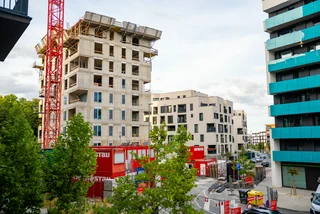Written by Richard Gürlich
of GÜRLICH & Co.

Contract for Work for house construction The subject of Contract for Work is very comprehensive, so it it easier to break it down into two sections, namely Contract for Work for house construction and Contract for Work for house with flats and non-residential areas. A Contract for Work for house construction describes the execution of certain work, i.e. construction of new house, as a family house as a rental house. In such a house there will not be flats and non-residential areas segregated as individual units. The contract is concluded between a client – the future owner of newly built house and a contractor – building company or a builder that will build the house. A house for rent, after its recording into cadastre of real estates, can be divided into individual flats, non-residential units and common parts of house by means of Statement of the Owner and its entry into cadastre of real estates. This is the common method of construction, chosen by developers. The contract for construction of a house with flats and non-residential areas that are considered as units refers only to a house in which there are or should be flats and non-residential areas from the beginning. Flats and non-residential areas are units, according to the law on ownership of flats, provided the house is divided into individual flats by means of a Statement of the Owner. This covers non-residential areas and common parts of a house and it is possible to own the individual flats and non-residential areas of the house. The contract for the construction of a house with flats does not primarily regulate the relation between the client of the house construction (the future owner) and construction company, but it regulates relations between the persons that want to build the house that will become flats or non-residential areas (still owned by them) and those that will jointly co-own the common parts of a house. Contract for Work for house construction A contract for house construction is covered by the Commercial Code as a Contract for Work. The contract stipulates the mutual rights and duties of the client – the future owner and the contractor – most often it is the construction company that will complete the construction. In order to ensure that it refers to Contract for Work according to the Commercial Code (and not to an undefined contract) it is necessary to include several elements, namely determination of the parties, i.e. client and contractor, determination of the work and stipulation of price or the method of its determination. In the case that it is a Contract for Work, and such a contract does not raise certain questions, it will be processed according to the respective provisions of the Commercial Code about Contracts for Work. The Commercial Code allows quite a lot of scope for contractual freedom and so the parties to the Contract for Work can change some of the rights and duties in the contract, somewhat differently than proposed within the Commercial Code. Parties to the contract It is recommended that the parties to the contract are as clearly identified and verified as possible. It is also recommended that date from the Trade Register is verified in order to minimize the risk of contract invalidity. Definition of work Furthermore, it is necessary to precisely describe and define the work, i.e. in this case the house that is to be built. The ideal situation occurs when the project documentation and further relevant documents form the integral part of the contract as attachments. During the work performance itself it is important that the contractor is allow to execute the work independently and not be bound by instructions of the client regarding the performance of the contract, unless the contract specifically allows this. The contractor may authorize another person to execute the work, provided it does not impinge upon the performance. In this case, the third party, acting for the contractor, has the same responsibility for the work as the contractor. It is also necessary to define whether the client is authorized to execute any construction works by covering the costs himself, then such work is not included within subject of Contract for Work. The contract should stipulate when the stages of construction will be completed.. On the basis of such a schedule it will be possible to check and to monitor the procedure of construction. The schedule is connected to a construction site diary. Price of work Clearly, the client is obliged to pay the contractor the agreed price. Should the price not be agreed and the contract remains valid, then the client is obliged to pay the price that is usually paid for comparable work, under similar commercial conditions. It is undoubtedly more convenient to agree the price in advance or, if not, a method of determination to avid disputes in the future. Therefore it is recommended that the price stated in the contract should be stipulated with respect to the budget and calculation of costs. The budget should include a description of individual partial actions, including stipulation of price of work and material. The price stipulated according to this budget should not be changed during the course of the performed works. It is possible that the price can change in the event of additional work. Should the work progress in stages, it is important to be able to formulate clearly the method of measuring the performance to ensure it complies with the contract. This is particularly important in the case of advance staged payments. Construction site diary The construction site diary represents one of the tools by which an inspection can check progress. During its use the contractor is obliged to entry the process of construction and the conditions under which the construction has been performed. The construction site diary further includes the deviations from the project and who has approved them, as well as other changes. Should there be a legal issue later, the site diary is very important as the data included in it may serve as important evidence. The original of diary is taken over by the client, from the contractor, after final building approval and according to the Building Act he is obliged to keep it for the period of ten years. It has its significance in case of the appearance of latent defects. Handover of work The handover of work is the transferred ownership rights and the possibility to pass on responsibility for defects to the client. In order to avoid any discrepancies it is recommended that the contract includes the method of handover, i.e. how it will be arranged, by whom and the logistics of the handover. Last, but not least, the handover is significant because the 10 year guarantee period starts from the handover. Defects of work According to the Commercial Code the work has defects should the work not correspond to the contract. If the contract states that the work must be faultless, then the work must be complete without defects. Even if the client takes over the handover, defective work cannot be classed as performed work, as per the courts. Assuming that it was not agreed between the parties otherwise, the contractor in such cases is not entitled to be paid for the work. In practice it is stipulated in the contract that the work is considered as performed even it shows defects, but not so that the defects stop the normal functioning of the house. It should be made clear that this refers to a very narrow definition of defects. The contractor is not responsible for defects when such defects have been caused by use of materials/ processes arranged by the clients that is beyond the reasonable care of the contractor Or when the contractor is forced to use certain materials against advice to the client. Should the work have defects it is possible to stipulate a number of sanctions, namely in form of a contractual penalty for delay or discount of price for decreased quality, etc. There are many alternatives to enforce and to set such sanctions (e.g. by a certain percentage from price of work, by certain amount, etc.). Simultaneously, it is advisable to include in the contract the obligation of the contractor to draw the attention – at the latest by the date of contract signature – of defects or discrepancies in project that he should discover as part of his professional care. In the course of construction the constructor should have the possibility to view the respective documentation at any time. From the point of view of the client it is advisable to stipulate in the contract that the work is thus faultless provided the final building approval – by which the use of house is allowed to be used – has been issued by the Building office. Guarantee for quality The parties may agree in the contract the guarantee for quality of work . The contractor takes over the commitment that the work will be capable of performing the agreed use for a certain agreed period. Conclusion A carefully prepared contract is one of key elements in the process of house construction. To ensure the legal security of the parties, the contract should formulate the rights and duties of the parties very clearly. This is significant should matters turn into a dispute. Therefore it is certainly recommended to have a written contract. *** Contract for construction of house with flats and non-residential areas The contract for the construction of a house with flats and non-residential areas has to be concluded by all persons that will share the house construction and who later become the owners of the individual flats and non-residential areas in the house.( after its completion and record into cadastre of real estates). All such persons will be considered as constructors of the house as per the Building Act. It means that all of them will apply for building permits. The contract is needed if the house already exists and there are within it – by means of a statement of the owner deposited at the cadastre of real estates – defined individual flats, non-residential areas and common parts of the house. Additionally, this includes plans for new flats or non-residential areas in a roof extension, loft built-in area, additional extension or general planned modifications. The contract should contain all the details of the new flats or non residential area and to what extent these affect the common parts of the house. In this case the contract has to be concluded by the all owners of the existing flats and non-residential areas within house, as well as the person intending to build the new unit (and thus become the owner of such new unit), or the owner of present flat or non-residential area in house who intends to enlarge the flat or non-residential area at the expense of common parts of the house. In this situation the constructor will be the only the person that will become the owner of the newly constructed flats or non-residential areas in the house or the owner of the unit enlarged at the expense of common parts of a house. The Law clearly defines what essential terms the contract has to include. The main areas include the name of cadastre area, plot number, adjustment of the rights of the owners of future units to the plot upon which the house will be built, numbers of all flats and non-residential areas including designation and location, determination of extent of floor area of the individual flats and non-residential area, their equipment and identification of all future owners. Besides the above, the contract has to include the method of determination of the common parts of the house that will be common to owners of all units as well as the determination of the parts that will be common to owners of only some units. Additionally, the contract includes stipulation of the co-ownership share of the common parts of house or method of administration of the house and plot, who represents the co-owners of house externally, how and for how long. Simultaneously, it is necessary to define, within the contract, the method of financing the construction costs, the amount and dates of such contributions, and the method for evaluating the work of future owners of units in a house, rules for contribution of co-owners of house for costs connected with administration, maintenance and repairs of the common parts of the house at completion and, as an attachment, the ground plans of all floors.. The contract may also include further provisions regulating relations between future owners. In the case that one of the future owners of a flat or non-residential area is also the owner of a plot upon which the house will be built, he is obliged to transfer the co-ownership share to the plot to the individual owners of flats and non-residential areas in the house. The size of such share is equal to the size of the share of the common parts of a house. Transfer of a co-ownership share to the plot has to be included in the contract. Provided one of future owners of flat or non-residential area has another right to the plot on which the house will be built, such as the ownership right (e.g. right of lease, real burden, etc.), he is obliged to transfer the given right to the other owners of the flats or non-residential area in house. The law also defines the obligation of the owner of the plot on which the house will be built, to provide ownership rights to this plot in such a way that the extent of these rights to this plot corresponds to the extent of co-ownership shares on common parts of a house. There is an obligation of the owner of a plot to provide, to the owners of flats or non-residential areas, all necessary co-operation and to conclude with the owners of flats and non-residential areas a written contract in order to transfer the respective rights and respective shares of such a right. If such an obligation is not included, then the owner of the unit in house disposing of the right to a plot, in many cases, cannot fulfil his legal obligation to transfer the respective rights onto other owners of unit in a house. The contract for construction must be attached to an application for the issue of a building permit. It is necessary to point out that building offices do not always have a full understanding of the law and they do not have to require the contract for the issue of a building permit. So, the building permit and final building approval of construction, and ultimately the new unit may be issued also without submission of the contract. One may enter problems during the record of the house and new units with cadastre office because this office does require the contract. Should the owner not submit it, then the office will refuse the proposal for the deposit of the house or new units. Therefore I strongly emphasize the necessity to find out the legal requirements and not to rely only upon decision of the office. It is recommended that legal advice is taken, with the necessary experience and expertise. This should avoid many unexpected problems.
***
Purchase of real estate
The question of real estate purchases is presently enjoying great interest, due to the desire of many people to live in their own dwelling and ,for example, as a result of entrepreneurial activity. Additionally, relating to real estate contracts there could be a few legal pitfalls, that I will refer to. Due to the comprehensive nature of this subject it is necessary to split it up into several partial stages.
These stages can be categorised as follows:
1. Reservation contract
2. What you need to know about real estate before concluding the contract
3. Future Purchase Contract
4. Purchase Contract
5. Application of a mortgage
6. Record into cadastre of real estates
7. Contract of work for house construction
8. Statement of the owner
9. Partnership of the owners
10. Purchase through the intermediary of a legal entity
11. Cooperatives and membership of them












 Reading time: 12 minutes
Reading time: 12 minutes 
















